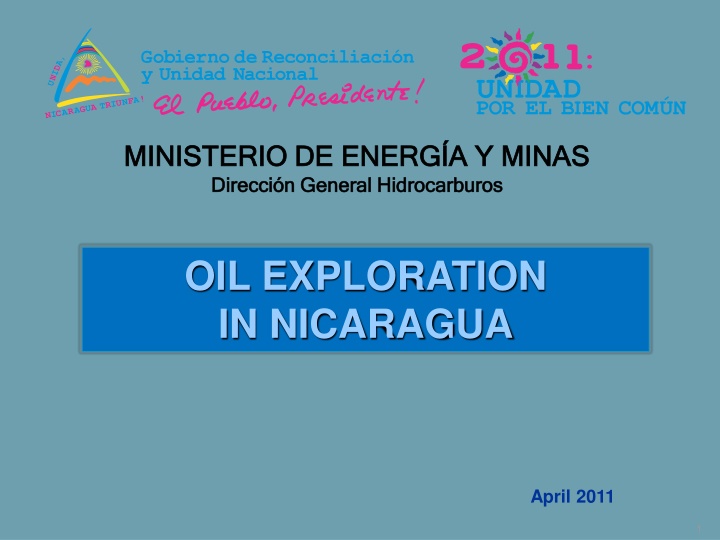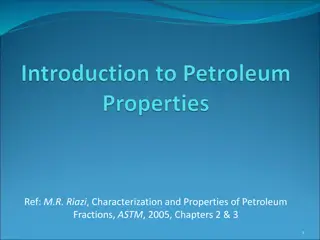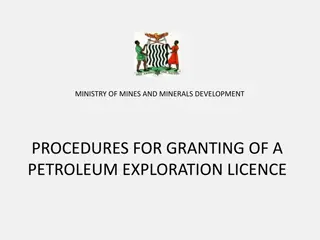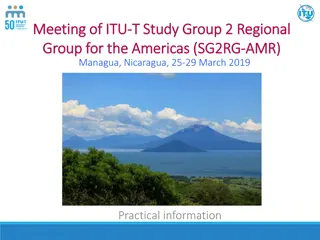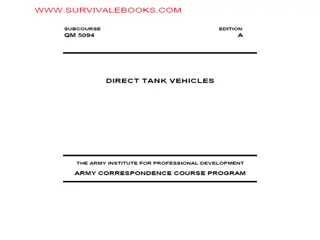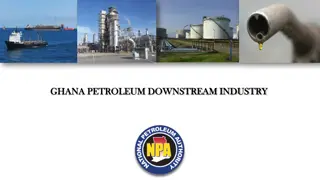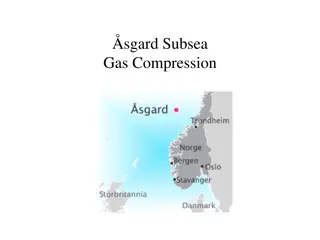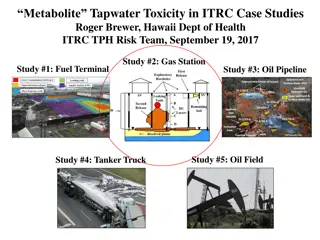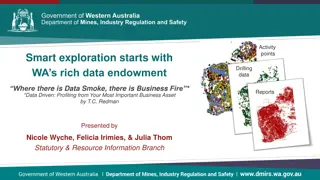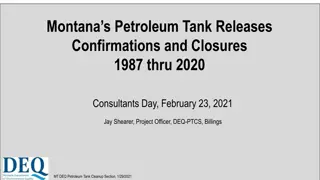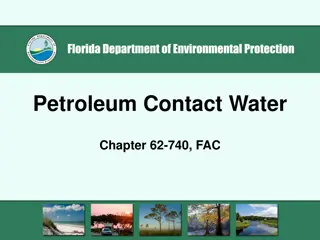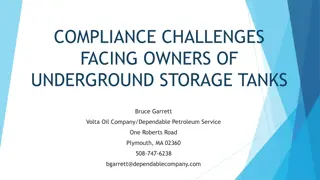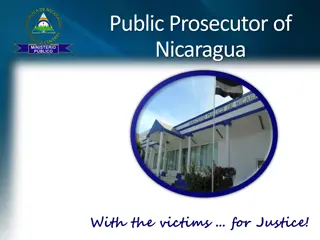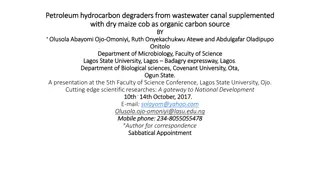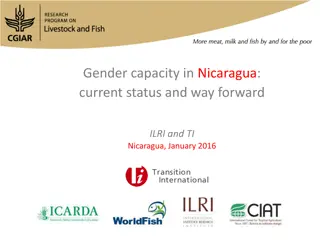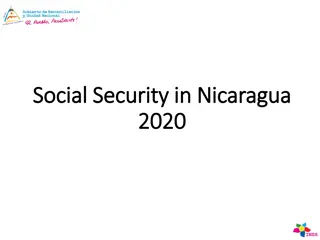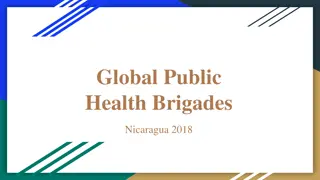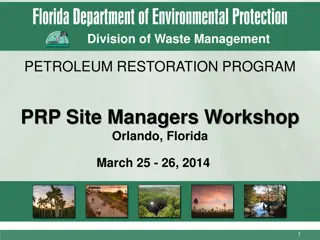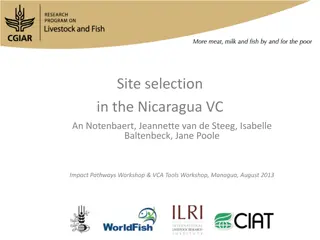Petroleum Exploration Activities in Nicaragua: A Comprehensive Overview
Nicaragua has a rich history of petroleum exploration, with activities dating back to 1930. The country has seen significant seismic acquisition and drilling efforts both onshore and offshore in the Caribbean and Pacific regions. Wells drilled in Nicaragua have shown promising oil and gas indications, with various companies involved in exploration activities. The available area for petroleum exploration covers over 100,000 km2, offering potential for further discoveries.
Download Presentation

Please find below an Image/Link to download the presentation.
The content on the website is provided AS IS for your information and personal use only. It may not be sold, licensed, or shared on other websites without obtaining consent from the author.If you encounter any issues during the download, it is possible that the publisher has removed the file from their server.
You are allowed to download the files provided on this website for personal or commercial use, subject to the condition that they are used lawfully. All files are the property of their respective owners.
The content on the website is provided AS IS for your information and personal use only. It may not be sold, licensed, or shared on other websites without obtaining consent from the author.
E N D
Presentation Transcript
MINISTERIO DE ENERGA Y MINAS MINISTERIO DE ENERG A Y MINAS Direcci n General Hidrocarburos Direcci n General Hidrocarburos OIL EXPLORATION IN NICARAGUA April 2011 1
PETROLEUM ACTIVITIES PETROLEUM ACTIVITIES Petroleum exploration in Nicaragua started in 1930, when the first well was drilled close to Managua in the Pacific Onshore. Period 1960 to date: Total 2D seismic acquired: 40 118 Km 31,973 Km. 2D 3,095 Km. 2D 4,620 Km. 2D 430 km 2D Pacific and Caribbean Offshore Caribbean Offshore Pacific Offshore Pacific Onshore 1960-1974 1999/2000 2004 2005-2006 Total 3D seismic acquired: 4 915 km2Caribbean Offshore 2010-2011 Total wells drilled: 37 26 Exploratory Wells in the Caribbean Offshore 8 Exploratory Wells in the Pacific Offshore 3 Exploratory Wells in the Pacific Onshore 2 Sidetrack Wells in the Pacific Onshore 1965-1974 1965-1978 2007-2008 2009
AVAILABLE AREA FOR PETROLEUM EXPLORATION ACTIVITIES LOCATION AREA GEOGRAPHIC COORDINATES 80 40 00 W and 83 43 00 W 10 56 00 N and15 54 00 N Caribbean Margin Offshore 68.489.00 km2 Pacific Margin Offshore 33.515,00 km2 85 49 00 W and 89 00 00 W 10 30 00 N and 13 05 00 N TOTAL AREA: 102,004 Km2 3
Oil & Gas Indications of Wells Drilled in Nicaragua Oil & Gas Shows WELL COMPANY YEAR TD (m) INTERV. (m) API FORMATION AGES OF OCCURANCE CARIBBEAN MARGIN Martinez Reef Miocene to recent Diriangen 1 Unocal 1975 1,967 600-1200 Mosquitia Punta Gorda Touche Mosquitia Kaman n Punta Gorda Mosquitia Touche Martinez Reef Mosquitia Kaman n Oligo-Miocene Upper Eocene Middle Eocene Miocene Upper Eocene M. & Upper Eocene Miocene M. to Lower Eocene Miocene to recent Miocene Lower Miocene 1400-1500 2500-2800 1533-1716 Coco Marina Unocal 1969 3,047 Ledacura Unocal 1977-8 3,791 1978-2006 1125-1743 3169-3462 474-878 900-1050 1081-1088 1164-1580 381 1800-2000 2400 3899-3466 1262-1838 C1 - C4 1bbl/d 30 36 Huani 1 Unocal 1974 3,468 7 bbl/d 28% C1 Huani 2 Unocal 1977 1,816 26 36 28% 28% C1 Mosquitia Kaman n Punta Gorda Touche Punta Gorda Miocene Lower Miocene Upper Eocene Eocene Middle Eocene Upper Eocene Oligo-L. Miocene M. & Upper Eocene Lower Miocene Oligocene-L. Miocene C1 - C4 Tuapi 1 Unocal 1978 3,923 C1 - C4 20% Miskito 1 Occidental 1970 2,027 1737 10% Kaman n Punta Gorda Touche Kaman n Punta Gorda Punta Gorda Touche Perlas 1 Shell 1968-9 3,800 3246-3342 1358-1981 2250 350 bop 21-26 12% 10% 10% Perlas 3 Shell 1970 3,802 Middle Eocene Upper Eocene Eocene Martinez Reef Unocal 1968 3,683 2150-3200 PACIFIC MARGIN Argonauta 1 1967 1,554 549 40 MM cf 25% El Salto Pliocene Superior Oil Co Corvina 2 1974 3,665 1400-2000 18% Miocene El Fraile(clay, siltstone and sand) El Paso Nicaragua San Bartolo-1 2006 3,665 1803-1813 241 bop 39 15% Eocene Brito Norwood Gas Shows Oil Shows Oil & Gas Shows Gas Flow During Testing Oil Flow During Testing 5
PETROLEUM POTENTIAL OF PACIFIC MARGIN OF NICARAGUA The Sandino Basin has a total thickness of 10 000 meters and was developed during the Cretaceous age. The Corvina-2 Well located in the offshore side, gave some hydrocarbon evidences. The 2D seismic reprocessed and the new onshore Geophysical, have given acknowledgment of the geological system and indicate the existence of structure capable to store hydrocarbon. seismic acquired by Gran Sand channel system was tested in the San Bartolo well located onshore, in the level of the Eocene, called Brito Formation. The complexity of the sand channel reservoir caused operation problems but some good hydrocarbon evidences have occurred reaching an accumulated production of 241 bop. 7
2D Seismic located in Pacific Onshore 430 km, acquired by Grant Geophysical 2005-2006 8
Drill Stem Testing Results Pacific Onshore of Nicaragua San Bartolo Well: (Brown Associated Inc.) In San Bartolo well four potential intervals were tested in a sandstones channel. Two sidetracks in San Bartolo well, gave a production of oil of 57.3 barrels of light oil with 38.5 API in the ranging depth between 6010 to 6295 feet. During testing a formation damage occurred causing low permeability. Oil shows can be related with natural faults systems connected with the porous sandstone section. best interval tested (7014 -7244 ) gave a permeability of 52 mD. transient analysis indicates the zone has permeabilities ranging up to 31 milidarcies. Flow rates over the test period averaged 99 bbls fluid per day of which 13.5 bbls were oil. The Pressure Mesa Gutierrez Mendez well: (Multiservicios de Perforacion Geopetroleros S.A. (MPG), Poza Rica) In the Mesa Gutierrez Mendez well, nine potential intervals were tested, no oil evidences was reported. Maderas Negras well: (Norwood) In the Maderas Negras well, six intervals were tested, an open fault caused mud lost. A shale cap of Oligocene age was identified in this well, which can act as a seal. Gas indication was reported. 9
Drill Stem Testing Results Pacific Onshore Of Nicaragua.. Accordingly to seismic interpretation, two different tectonism occurred during the deposition of Tertiary and Cretaceous. The Cretaceous base overlain Rivas Formation was identified in the Line NW 920, it is assume that the tertiary sequences was deposited after a tectonic shift of the Cretaceous sequences, suggesting different tectonic events. LINE: NW 920 Cretaceous Base 10
PETROLEUM POTENTIAL OF THE CARIBBEAN MARGIN OF NICARAGUA The Miskito basin has a sedimentary thickness that varies from 2,000 meters in the South to 10,000 meters in the North, their sediments were deposited during the Tertiary to Recent Times. Seismic interpretation and structural map in the central and southern part indicate: Intense thrusting and strike slip faulting. Tectonic blocks controlled the sedimentation, particularly the development of reef system along the elevated parts of fault blocks. Some wells drilled near the Perlas area had oil indicatios. Perlas -1 well producted 350 bpd in the Lower Miocene level. The Lower Eocene Facies are related with reef and fore reef system and also pinnacle reef system that can act as good limestone reservoir. 11
3D Seismic Survey, Caribbean Offshore 4,915 Km2, CGG Veritas, Noble Energy Inc.
New perspectives in the Caribbean of Nicaragua Dolomite section in the Punta Gorda Formation of the Caribbean Margin of Nicaragua. Dolomite Eocene Occidental in the wells Miskito- 1 and Miskito-2 in the Punta Gorda Formation level. This dolomite sequences stratigraphically similar to the one identified in some wells from Jamaica and Honduras. Offshore wells from Nicaragua indicate a range thickness of this section from 85 to 400 . Eight wells drilled Caribbean of identified this sequence and one well from Honduras. Troy was from recognized Middle by is in the Nicaragua
New perspective in Caribbean of Nicaragua. This presents predominant dolomitization part of the Punta Gorda Formation is independent depositional and has calcite material. dolomite limestone section with The shale. of the environment Dolomite section can be observed in some seismic section as a free reflexion. In the region of the Tyra well this section is related with the structure. Perlas reef
THANKS FOR YOUR ATTENTION THANKS FOR YOUR ATTENTION For further information: www.mem.gob.ni 16
